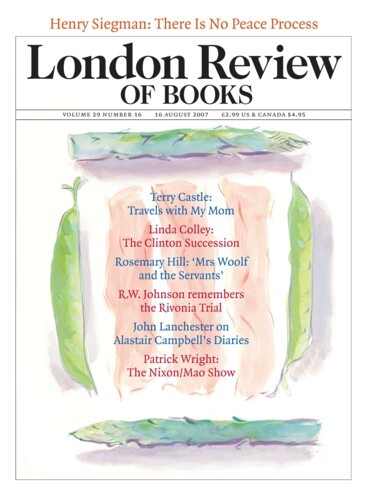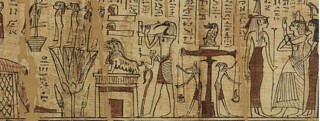Some forty years ago I found myself on an operating table. Looking up I could watch the dark line of a catheter as it was pushed along a blood vessel to deliver dye to the veiled, grey, globular mass that was my heart. It seems to me now that the X-ray images I saw on the monitor were a series of snapshots, not a continuous record, yet I also seem to recall watching injected dye enter the heart: that was the point of it all – to map the shape of the cavities blood usually filled. What I felt when the dye went in (I had been warned) was a body-wide blush. The experience was memorable, even if the memories are untrustworthy. Whichever way, real-time pictures were different from the ordinary X-rays I had already seen. I even now associate the gentle thump of my pulse, quick at that time, taken often and nervously, with the memory of an expanding and contracting shadow, although that memory may be an overlay, an extrapolation from things seen since such as the MRI scans in the Heart exhibition – at the Wellcome until 16 September. As much about the heart in the mind as about the heart in the body, the exhibition encourages introspection. A series of interviews in the accompanying book are more interested in what it feels like to be a surgeon or a patient than they are in actual heart operations.
Anatomies, dissections, scans, texts, paintings, film clips, manuscripts, playing-cards, a box for love letters fill the new exhibition gallery that opens out behind the giant Ionic columns of the Wellcome Institute’s 1930 portico. They do not add up to the informative account of cardiac biology and history you would expect to find in, say, the Natural History Museum. The modern crispness of the new spaces is really no more appropriate to Henry Wellcome’s passionate, omnivorous and in some ways absurd appetite for medical relics than the institutional solemnity of the Euston Road façade is. But this exhibition – for better and worse – is true to the Wellcome spirit. The history of our understanding of the heart’s function is not the greatest, or even the most coherent part of what is displayed. Anthropology and social history are as important. There are items that come close to being mere curiosities, and there are modern works of art – among the more famous, Andy Warhol’s print of a photograph of a heart – which milk the awareness we have, and most of the time suppress, of the blood-pump within the ribcage. The religious imagery of Christ’s (and in one case his mother’s) bleeding heart, the secular heart, pierced with Cupid’s arrow or simply broken – the folk art of the heart – draw on the same awareness in a more primitive way. For that reason they seem to connect more directly than the fine art does to such ancient things as the Egyptian papyrus of a Book of the Dead that shows the heart being weighed, its owner – the image is still embedded in the language – being found light or heavy-hearted.
One way the heart is hidden is straightforward. Despite my angiogram I still only knew my heart indirectly. That was how all living human hearts were known for most of history (if you except gory sacrifices and executions). More recently it became possible to listen closely to them; in the exhibition you can put your ear to a speaker embedded in the wall and hear the lubdub of a healthy heart and the slurp of a failed valve (a ‘mitral regurgitation’). After that came non-invasive imaging techniques that show more of what is going on. An MRI loop records the ineffectual flapping of the mitral valve that causes the slurping sound.
Only when you get to Jordan Baseman’s 13-minute film, Under the Blood, showing open heart surgery at Papworth Hospital, do you come face to face with direct images of the live, palpitating organ. Baseman’s soundtrack tells you nothing about what is being done. The only theatre-talk you hear is the odd mutter, and the ‘one, two, three, four’ of a nurse counting swabs, the only ambient noise the snap as wires tying the sternum back together are cut. Moreover, what you get to see is confusing (it is drawn from film of a number of operations), and although it does take you through a sequence – preparation, the opening of the thorax, work on the heart itself and the final sewing up – you have little idea of what exactly is being done and why. The accompanying voiceover is a Billy Graham sermon about blood (‘without shedding of blood there is not forgiveness of sin’). You are offered an experience but not an explanation – and maybe the experience is stronger for that reason.
The hidden heart – out of sight, thumping behind the chest wall – for many centuries concealed its function, or at least made it a matter of induction and speculation. The hunting field, the shambles and the embalming trough were sources of anatomical information, and as time passed human dissections allowed anatomical drawings and commentaries to be made. But received notions about function could determine what even a great anatomist thought he was seeing or should be able to see: Vesalius was at first so sure that there was communication across the septum that divides the left and right sides of the heart that he reckoned it must be penetrated by pores too narrow to be seen or felt out with a probe.
Jonathan Miller, in a lucid account of Harvey’s demonstration of the circulation of the blood, reckons that knowledge of pump technology must have had a part in the development of his ideas. You see what you expect to see. Because our textbooks have diagrams that show how the heart works (the facts are easy to forget) it is easy to believe that it was only a matter of looking to find out what was going on. But even when you have the right idea, looking can be difficult. Only by examining the slow-beating hearts of cold-blooded creatures – toads, serpents, frogs, snails, lobsters and prawns – and the flagging, dying hearts of warmer animals could Harvey determine the nature of the heart’s contractions. Although he could not see the fine capillaries that join arteries and veins any more than Vesalius could see pores in the septum, that they were there to be found was one of those predictions (an invitation to refutation) that science lives on.
The history of science is uniquely hard to follow. Plato’s ideas are not expunged by those of later philosophy. Histories of art, music, exploration, politics and so on are accounts of change, sometimes triumph or decline, but not usually of demonstrable error. To be wrong in science is to lose the game; you can have a Gothic revival but not a pre-Copernican revival. Asked to make sense of, say, Galen’s ideas, one must dismantle an edifice (in my case shaky) of modern knowledge. Wellcome-like omnivorousness encourages you to imagine what it would be like not to know.
Send Letters To:
The Editor
London Review of Books,
28 Little Russell Street
London, WC1A 2HN
letters@lrb.co.uk
Please include name, address, and a telephone number.


